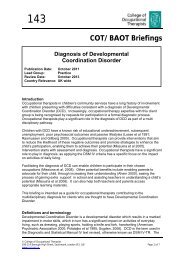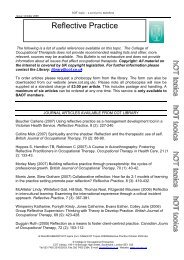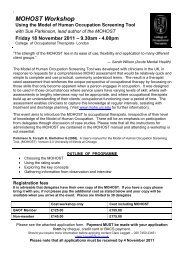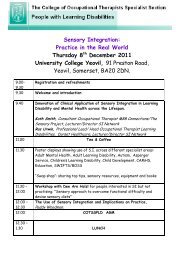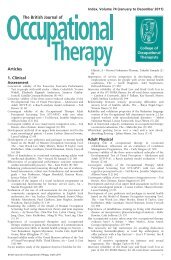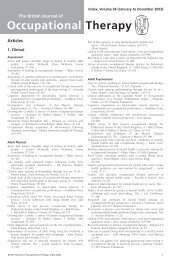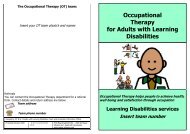Total hip replacement - College of Occupational Therapists
Total hip replacement - College of Occupational Therapists
Total hip replacement - College of Occupational Therapists
Create successful ePaper yourself
Turn your PDF publications into a flip-book with our unique Google optimized e-Paper software.
Introduction<br />
other members <strong>of</strong> the multidisciplinary team. This will commonly include information<br />
on any <strong>hip</strong> precaution protocols in place to reduce the risk <strong>of</strong> dislocation. With the<br />
advance <strong>of</strong> technology there is also the opportunity to consider other options, which<br />
could increase service user choice about how they access information, such as websites/<br />
mobile apps or digital television.<br />
Empowering the service user to take responsibility for their own health management is<br />
important, as it is believed that ‘expert service users’ will be more involved in their care<br />
and outcomes, leading to increased reablement following surgery.<br />
The service user story:<br />
“I was very impressed with the support I received from the occupational therapists<br />
when I was in hospital in January 2011. From the outset, their approach was pro- active<br />
and very soon after arriving at the hospital there was a group meeting with a member<br />
<strong>of</strong> the department. The purpose <strong>of</strong> this was to prepare us (pre- operation) for the<br />
pitfalls (post- operation) and how to avoid these. The do’s and don’ts were explained<br />
to us, we were shown how to dress, what aids we would have and how these could be<br />
used. This meeting helped to relieve anxiety and allowed us to prepare both mentally<br />
and physically for how we could cope post- operation. After <strong>hip</strong> surgery there were<br />
further individual meetings with occupational therapists, where I had to demonstrate<br />
my ability to dress as taught. I was also taken to the ‘home area’, to be shown how<br />
best I should move around the kitchen once home. After this demonstration, I was<br />
then observed putting this into practice. Before my discharge from hospital I had also<br />
to demonstrate that I could manage stairs using sticks/crutches as I had been taught.<br />
All the aids to support me at home had been supplied prior to my stay in hospital.<br />
However, the commodes had not been adjusted/fitted. In the hospital, my partner was<br />
given a very helpful demonstration by the occupational therapist so that he was able<br />
to adjust the equipment to suit me for my return home. All in all, I had an excellent<br />
experience as a patient at the Golden Jubilee and I am very grateful for the part the<br />
occupational therapists played in that experience. What impressed me most was the<br />
team- work displayed not only with the occupational therapy dept., but across all the<br />
departments/groups involved in my care. Nurses, surgical team, doctors, occupational<br />
therapists, physiotherapists, auxiliaries, cleaning staff – everyone seemed to know what<br />
part he/she had to play, when it was to be played and how in terms <strong>of</strong> patient care. This<br />
close working together made for efficiency and a high standard <strong>of</strong> care – all <strong>of</strong> which<br />
reduced anxiety for me and made me feel confident about my outcomes postoperation.<br />
. . .Forgot to say how useful the brochure ‘Patient Guide to Hips’ was in<br />
preparing me pre and post- surgery. Practised exercises pre- op, which made it easier<br />
post- op.”<br />
Golden Jubilee National Hospital service user feedback<br />
Hip precautions, which are restrictions on range <strong>of</strong> movement and activities undertaken<br />
by the service user, were traditionally implemented as a preventative measure. The aim<br />
was to reduce the likelihood <strong>of</strong> dislocation by facilitating the healing <strong>of</strong> s<strong>of</strong>t tissues<br />
surrounding the replaced <strong>hip</strong> (Restrepo et al 2011).<br />
Variations exist in practice; some services now have no routine <strong>hip</strong> precautions, but<br />
where they exist, these generally advise not to flex the <strong>hip</strong> beyond 90 degrees, and to<br />
avoid adduction and rotation <strong>of</strong> the <strong>hip</strong>. Risk <strong>of</strong> dislocation can be influenced by factors<br />
such as surgical approach, and whether surgery is completed electively or post- trauma.<br />
<strong>College</strong> <strong>of</strong> <strong>Occupational</strong> <strong>Therapists</strong><br />
11



